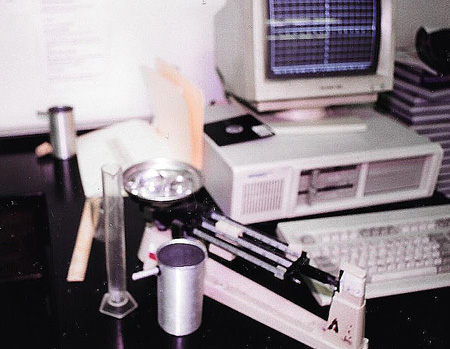Lab 3: --Density of Solids

LAB III. MASS, VOLUME AND DENSITY OF A SOLID
Problem: What is the relationship between mass and volume of different geometric solids made of the same material?
NOTE: DO NOT BEGIN YOUR EXPERIMENT UNTIL EACH MEMBER OF YOUR GROUP HAS READ THE BACKGROUND AND ANSWERED THE BACKGROUND QUESTIONS.
Background and Inquiry: Density is defined as mass per unit of volume. The units for density are gm/cm3. The equation for density is D=M/V. To find mass use the triple beam balance. To find volume there are 3 methods, the first two are displacement methods,
1) you can
drop the object directly into a graduated cylinder partially filled
with water and see what the displacement or change in volume is
(use this method only for the very small cube),
2) use an overflow bucket to measure the volume of displaced liquid,
or;
3) Use the geometric method as shown in class.
Discuss with your group the various equations used to find the volume of different solids: cube, rectangular solid, cylinder and sphere.
Volume of
a cube = (side) 3
Volume of a rectangular solid = length x width x height
Volume of a triangular prism = 1/2 bh (of triangle) x height of
the prism
Volume of a cylinder = (3.14) (radius of cylinder) 2 x
height of cylinder
Volume of a sphere = (3.14) (radius of sphere)3
Today you will observe what happens to the mass of an object when the the volume is increased if the density or material of each object remains the same. What do you expect will happen to the mass if the volume is increased? For example if the volume is doubled what would happen to the mass? What type of mathematical relationship do you expect to observe? Justify your statement!
Background Questions:
1) Define
density. Give an example showing how to find the density of an
object.
2) Describe 3 ways you could find the volume of a small sphere.
3) A cube has a side of 3 cm. And a mass of 56 gms. What is the
density of the cube?
4) A
sphere has a diameter of 5 cm. What is it's radius? What
is it's volume?
5) Explain what the slope of a graph is. How do you find it?
State your hypothesis. Justify your statement!
Materials: triple beam balance, Plexiglas solids, graduated cylinder, overflow bucket, beakers
Procedure:
1) Copy Table
I into your lab notebook.
2) Find the mass of each of the objects, from smallest to largest.
Let each member of the group repeat this. Take an average if necessary.
3) Record your data in table I.
4) Find the volume of each object using both the geometric method
and displacement method (using the overflow bucket as described
in class or graduated cylinder for the smallest cubes). Again
record only the average value in table I. Complete the last column
in table I by dividing the mass by the volume of each sphere.
Results:
Complete the following table.
| Solid Name | M, (Mass,g) | Volume, cm3. (Geometric Method) | Volume, cm3 (Displacement Method) | Average Volume cm3 (using both methods) | Density g/cm3 (Mass/Avg.Volume) |
| A | |||||
| B | |||||
| C | |||||
| D | |||||
| E | |||||
| F | |||||
| G | |||||
| H | |||||
| I |
Graphing: Draw a graph plotting mass on the y-axis and average volume on the x-axis. Make sure to label your graph. Find the slope of the graph.
Discussion:
Be sure to include the following:
1) What are
the variables used in this experiment?
1) How are the variables changing with relationship to each other?
2) What were some factors or conditions that you held constant
while doing this experiment?
3) What type of relationship does your graph demonstrate?
4) Make sure to discuss the meaning of the slope of the graph
5) Discuss why you average the two volume methods.
Lab Activities and Resources
What are Mathematical Relationships
What is a mathematical relationship andWHAT ARE THE DIFFERENT TYPES OF MATHEMATICAL RELATIONSHIPS that apply to the laboratory exercises in the following activities.
Labs
Lab 1: -- Problem: What is the relationship between how much a spring stretches and the force pulling on the spring?
Lab 2: The Pendulum --Problem: What is the relationship between the period of a pendulum and the length of the string of the pendulum?
Lab 3: Mass, Volume and Density-- Problem: What is the relationship between the mass of a ball and its volume assuming a constant density?
Lab 4: Light Intensity-- Problem: What is the relationship between the intensity of a beam of light and the distance from a light source?
Lab 5: Acceleration-- Problem: What is a the relationship between how the distance travels and the time in travel for an accelerating object?
Lab 6: Polarization -- Problem: What is the relationship between how much light passes through a Polaroid filter and the angle the filter is rotated?
Lab 7: Ohms Law-- Problem: What is the relationship between current, voltage when there is a constant resistance in an electric circuit.
Lab 8: Radioactive Decay-- Problem: What is the relationship between the decay of radioactive material and the time allowed for the decay?
Lab 9: Water Pressure-- Problem: What is the relationship between water pressure and depth of water?
Lab 10: Attractive and Repulsive Forces-- Problem: What is the relationship between the distance between two magnets and the force between them?
Lab 11: Damping Motion-- Problem: What is the relationship between the height a ball bounces and the number of times it has bounced?
Lab 12: Buoyancy - Problem: What is the relationship between the volume of a boat and the weight it can hold?